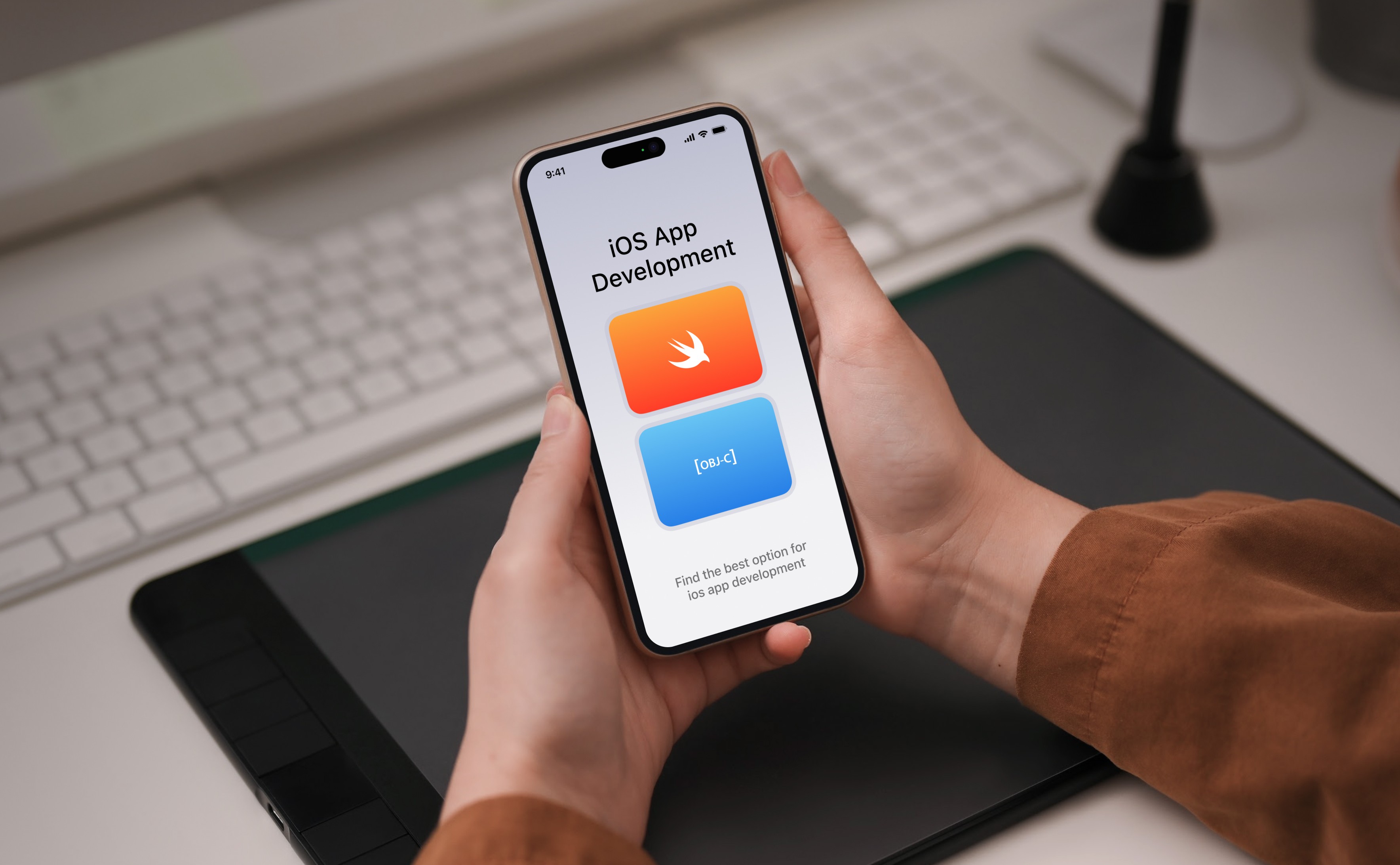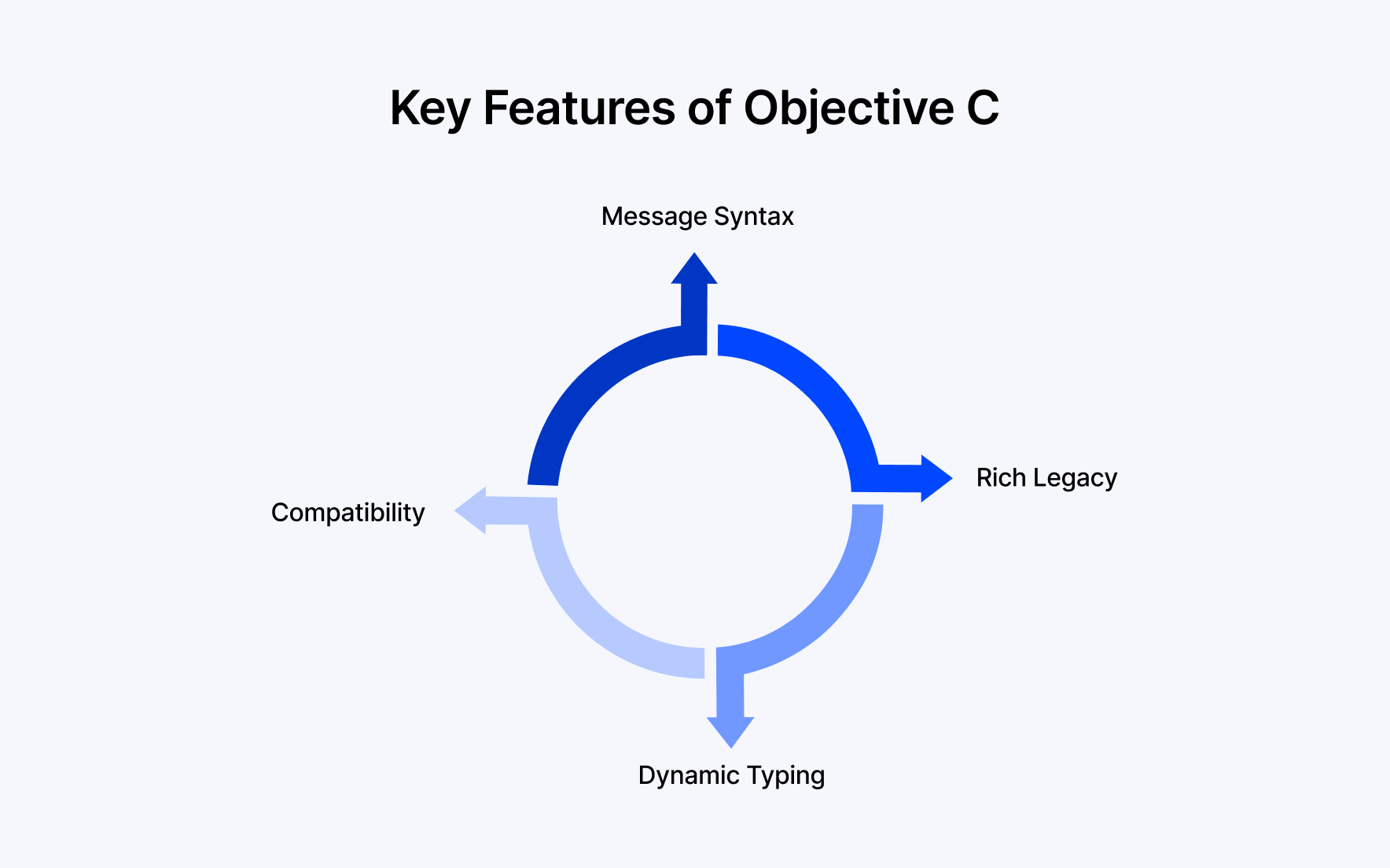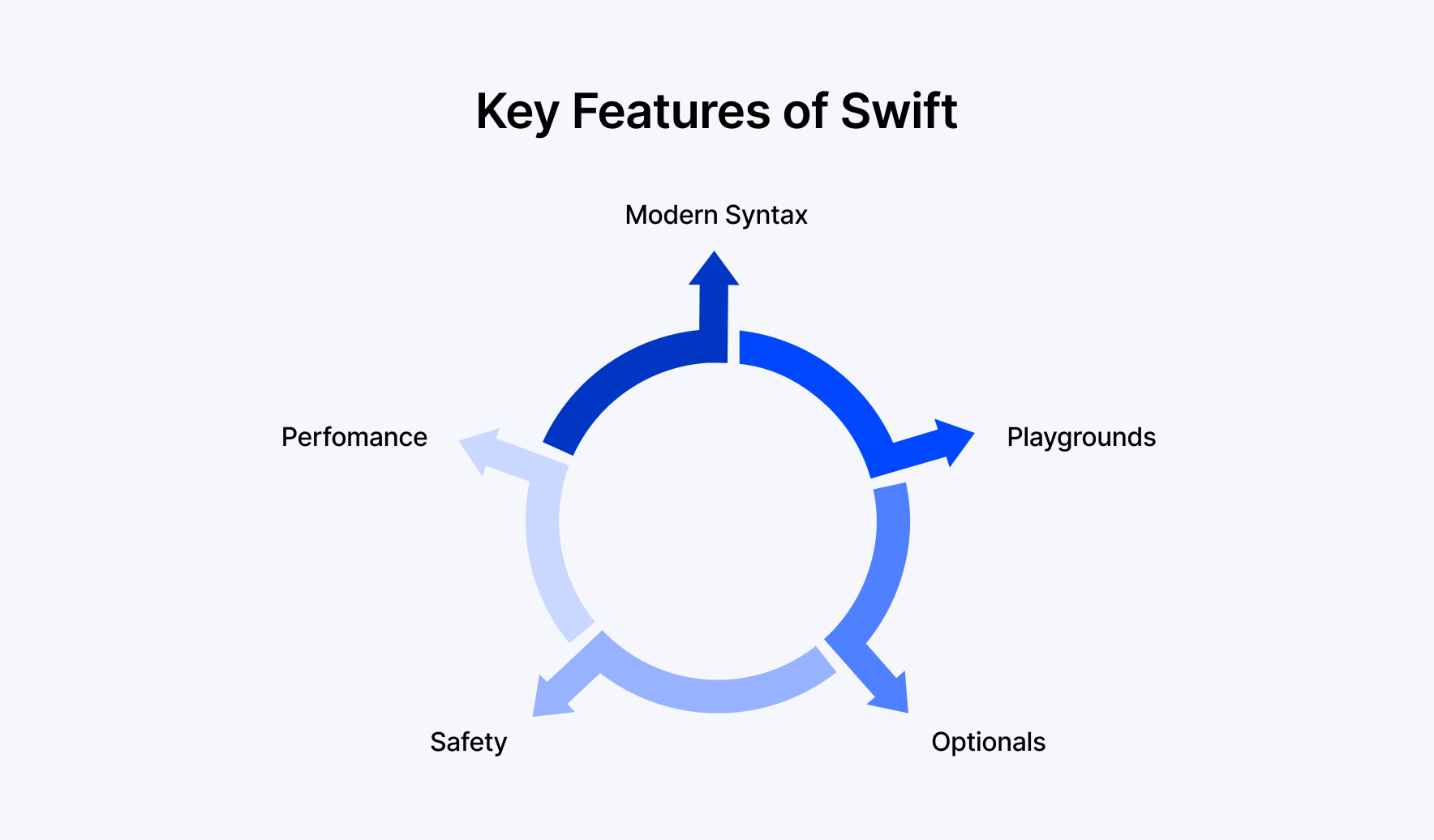Swift Vs. Objective-C: Which is the Best Option for the 2026 iOS App Development?

When planning to develop an iOS application, determining the right programming language is crucial. Development language forms the foundation of any app, significantly impacting its scalability, performance, and long-term success. Coming to iOS development, the classic rivalry between Swift vs Objective-C continues to divide developers in their choice of the appropriate programming language.
With over a billion active iOS devices in 2025 and a growing user base, it is imperative to choose the right programming language, as the wrong choice can lead to a range of limitations and maintenance issues. Hence, understanding the key differences between the two main competitors, Swift vs Objective-C, is important. Even though both languages are supported by Apple, they come with their own distinct sets of advantages and downsides.
This blog breaks down the core differences between these programming languages, enabling developers to make perfectly informed decisions for their next iOS project.
Quick Summary
Objective-C is a stable and mature language, making it ideal for maintaining dynamic legacy code. Swift is modern, fast, and safe, perfect for the new iOS project demands. The former relies on old frameworks while the latter is considered the future of Apple. Project goals, vision, team expertise, and technical constraints determine the choice.
What is Objective-C?
Objective-C is an object-oriented, general-purpose programming language that was the standard primary language for iOS and macOS before Swift. Based on the C programming language, Objective-C employs Smalltalk-style messaging, making it a flexible and dynamic language.
The Stepstone company developed this well-established programming language in the early 1980s as an extension to the C programming language, and Apple adopted it in the late 1990s. Objective-C enables developers to tackle complex tasks with ease, emphasizing its dynamic nature to handle both small and large programs. Still, the language can appear intricate and challenging for newcomers, due to its syntax rooted in the C programming language. Manual memory management is another challenge compared to its modern counterparts.
2312 companies reportedly use Objective-C in their tech stacks, including Uber, Pinterest, and Instagram. (Stackshare)
Let's have a quick recap on some of the top features of Objective-C and how it stays relevant as a powerful programming language even today.
Features of Objective-C
- Dynamic Typing: Objective-C exhibits dynamic typing capability, allowing developers to determine the object type right at runtime, rather than at compile time. The feature helps developers to compose flexible and adaptable code, especially when the exact object type may not be known upfront.
- Message Syntax: Objective-C utilizes messaging syntax derived from Smalltalk, rather than traditional function calls in C or C++ languages. This enables developers to directly send messages to an object, for eg: [object message]. The syntax resembles natural language and enhances readability, making code more instinctive and allowing developers to dynamically choose between methods to invoke during runtime.
- Compatibility: Objective-C exhibits seamless compatibility with C and C++ codes. This is because Objective-C belongs to the C programming language superset, making every valid Objective-C code a valid C code. This compatibility helps developers to use the vast legacy of C libraries and codebases along with Objective-C’s specific object features. Moreover, Objective-C’s effortless integration with Apple’s Cocoa Touch frameworks made it the backbone of iOS and macOS development before the introduction of Swift.
- Rich Legacy: With a decade-long journey, Objective-C demonstrates a rich set of libraries, tools, frameworks, and a community base. It portrays a legacy of powering thousands of successful iOS and macOS applications, which accounts for its reliability and scalability as a programming language. The rich legacy underlines the fact that a vast amount of codebases, documents, and communities still rely on Objective-C, making it quintessential for maintaining or integrating with long-established applications.
What Is Swift?
Swift is a modern, powerful programming language, introduced by Apple in 2014. Developed by Apple employee Chris Lattner, the language is considered a much advanced, easy, fast, and safe version of Objective-C. The popularity of the language accounts for its steady compatibility across macOS, iOS, watchOS, tvOS, and even Linux. The Stack Overflow survey revealed that 62.88% of developers loved using Swift, while only 23.44% were interested in Objective-C.
Due to its concise and expressive syntax, automatic memory management, and other modern feature sets, both beginners and experienced developers find Swift easy to use. The optional and type inference in this development language helps developers to compose short and neat code, resulting in fewer crashes and bugs compared to Objective-C. Overall, this rapidly evolving programming language exhibits great potential and is even accessible to those accustomed to other programming languages like Python and JavaScript.
Apple introduced Swift as a revolutionized, efficient alternative to Objective-C’s shortcomings. Given below are some of the standout features of the language, making it a prime choice among developers.
Features of Swift

- Safety: Basically, Swift was designed with safety as a priority. Swift reduces the probability of bugs and crashes by swiftly eliminating entire classes of unsafe code. Its early error detection capability, strict type systems, automatic memory management, and practices like variable initialization focus on detecting errors well in advance and reducing runtime crashes. Features like “optionals” and “error handling” precisely manage null values and eliminate unexpected errors. The safety feature of Swift is a significant step up from Objective-C, which is more susceptible to runtime errors due to its looser type enforcement.
- Performance: Swift is named “Swift” for a reason! It has a high-performance code that handles tasks in a fast and easy manner compared to Objective-C. It uses the LLVM-optimized compiler that offers remarkable performance compared to compiled languages like C++. It reduces overhead by replacing some of Objective-C’s features, like message dispatching, with static patterns. Improved memory management and faster algorithms are other features that enable Swift to outperform Objective-C in almost all cases.
- Modern Syntax: Swift’s syntax is clean, concise, and expressive compared to Objective-C’s verbose syntax, rooted in C. The compact syntax pattern aids developers in efficient code readability and writability. It minimizes boilerplate code due to being closer to natural English syntax, which improves developer productivity and reduces the time to compose and maintain code. High-end features like closures, string interpolation, tuples, and inferred types facilitate a seamless experience, especially for new developers.
- Playgrounds: Swift offers a feature-rich and interactive environment that allows developers to experiment and learn in real time. The feature helps in learning, visualizing, and prototyping the algorithm's behavior. Developers can enjoy this flexibility to compose code and evaluate the output without the need to build or run a full application. This feature set is not natively available in Objective-C.
- Optionals: Optionals help in reducing errors caused by null values. It provides a way to handle null values, prevent runtime crashes, and improve code stability. This powerful feature enforces better code practices to avoid nil-related issues, which are common in Objective-C, where sending a message about null values can lead to silent bugs or indefinite behaviour.
Quick Comparison between Swift Vs. Objective-C
Below is a quick comparison between Swift vs. Objective-C based on some key metrics.
FEATURE | SWIFT | OBJECTIVE-C |
|---|---|---|
Syntax & Readability | Clean, Concise & Modern. | Dated & Verbose. |
Performance | Faster & Efficient. | Slow due to legacy code. |
Safety & Error Handling | Strong safety features like Optionals. | Runtime errors are more common. |
Interoperability | Interoperable with Objective-C. | Offers full interoperability. |
Tooling & IDE support | Excellent & strong support in Playgrounds, Xcode. | Mature but less intuitive & lacks modern features. |
Ecosystem & Community | Flourishing rapidly. | Established & Rich in resources. |
Maintenance & Scalability | Easy to maintain in the long term. | Hard to scale & maintain. |
Language Maturity & Support | New & rapidly evolving. | Stable and mature. |
Developer Productivity | Superior productivity. | Slower production. |
Long-Term Viability | Actively supported by Apple. | Slow phasing-out. |
Want expert guidance across both iOS languages?
Let's talkLoading...
Key Differences Between Objective-C Vs. Swift?
Detailed below is a point-by-point comparison of Objective-C vs. Swift, followed by a verdict on which one thrives as a better development language.
‣ Syntax & Readability
SWIFT: Swift exhibits a clean and modern syntax with less clutter, which improves code readability, writability, and development speed. Having characteristics close to natural language, it reduces boilerplate code, helping developers to work effortlessly on complex systems.
OBJECTIVE-C: Objective-C features a lengthy, verbose, and complex syntax that may appear daunting to new developers. Due to its reliance on features like dynamic messaging and square brackets, it can be difficult to comprehend. Though having a steeper learning curve, Objective-C offers extensive control and flexibility.
🏆 VERDICT: Swift wins for its concise syntax, better readability, and lower learning curve, resulting in fast onboarding of projects.
‣ Performance
SWIFT: Due to automatic memory management and LLVM compiler optimizations, Swift offers fast and seamless code execution. Designed for high performance, it often outshines Objective-C in tasks like memory management, type-checking, and handling complex algorithms.
OBJECTIVE-C: Stable but lags in high-performance case scenarios. Since it uses legacy code, it can cause performance overhead, making it slow compared to its modern counterparts.
🏆 VERDICT: Swift is the winner, as its static typing and compile-time optimizations offer superior performance compared to Objective-C.
‣ Safety & Error Handling
SWIFT: Safety is the core of Swift. Strong safety and error handling features like strong typing, optionals, and automatic memory management effectively reduce runtime crashes and prevent common bugs.
OBJECTIVE-C: Even though flexible, Objective-C is more prone to errors and calls for extra diligence in ensuring code safety. It lacks strict null safety and uses manual memory management, resulting in more runtime crashes.
🏆 VERDICT: Swift appears significantly safer due to its robust safety mechanisms and error-handling techniques.
‣ Interoperability
SWIFT: Blends well with existing Objective-C codebases. Its interoperable nature ensures gradual migration and the use of dynamic code, but can sometimes cause friction due to complex bridging.
OBJECTIVE-C: Exhibits excellent interoperability with Swift. With proper bridging, it can operate with Swift methods, but the real challenge comes when integrating new feature sets.
🏆 VERDICT: Almost a Tie! Both Objective-C and Swift offer solid interoperability. The choice must be made based on the project requirement - modern or legacy.
‣ Tooling & IDE Support
SWIFT: Swift is supported by modern, improved tools like Playgrounds and Xcode. Apple keeps on improving and updating its efficiency, making it more future-ready.
OBJECTIVE-C: Mature but lacks modern, engaging features. It portrays stable tooling with fast compile times. Xcode was originally designed for Objective-C, so the tooling support remains the same and stable for legacy apps.
🏆 VERDICT: Swift wins as it offers a more productive and reliable developer environment with its future-focused updates and tooling improvements.
‣ Ecosystem & Community
SWIFT: Has a vibrant ecosystem and third-party support. It has a growing community specifically for macOS, iOS, and server-side development. Open-source contributors are driving rapid and swift innovations in Swift.
OBJECTIVE-C: Objective-C is long-established but is slowly turning outdated. Being the first of its kind, it exhibits a large legacy of developers and enterprise apps, but appears obsolete for new community initiatives or updates.
According to Reddit, Swift has significantly more community support with 128K members compared to the Objective-C framework with only 7K members.
Swift has 336,370 questions on Stack Overflow, reflecting a robust community for knowledge sharing. Whereas Objective-C has 292,009 questions on Stack Overflow, but only 39 questions are asked per week, indicating declining community engagement compared to Swift.
The above data reflects on the broader adoption and active developer interest rate of Swift in modern iOS development.
🏆 VERDICT: Swift remains the choice of the future because of its active, vibrant, and consistently updated community support.
‣ Maintenance & Scalability
SWIFT: Swift is faster to iterate, easier to scale, and maintain. Thanks to its modern architecture and advanced safety features. It becomes specifically useful for large teams and enterprise-grade apps.
OBJECTIVE-C: With its dynamic legacy code, Objective-C appears harder to scale and maintain. Because of its verbose, lengthy syntax and potential runtime issues, it becomes a task to handle Objective-C codebases.
🏆 VERDICT: Swift is easy to maintain and offers better scalability. It is the best choice for modern and scalable codebases.
‣ Language Maturity & Support
SWIFT: Swift has significantly matured over time, especially since Swift 5. Constant updates from Apple and ABI stability account to its ever-evolving nature.
OBJECTIVE-C: Portrays a long legacy, hence is highly mature. But it's no longer enhanced or supported by Apple, hence hit a stagnant status.
🏆 VERDICT: Swift should be the futuristic choice, accounting for the continued support and updates provided by Apple. Objective-C, even though mature, appears dated.
‣ Developer Productivity
SWIFT: Enables faster development with features like clean syntax, strong typing, and playgrounds. It ensures easy debugging with less boilerplate code.
OBJECTIVE-C: Showcase low productivity and is more prone to errors. Features like dynamic typing can cause hidden bugs, which in turn can affect the overall development time.
🏆 VERDICT: Swift facilitates improved productivity with its superior performance and ease of error detection and fixing.
‣ Long-Term Viability
SWIFT: Most new frameworks are “Swift-first” or Swift-only”. It is the future of iOS development, with Apple constantly investing in developing it.
OBJECTIVE-C: Mature and stable, but is being phased out. Popular among legacy applications, but no longer a good fit for new projects.
🏆 VERDICT: Swift tops the vote as a long-term winner, specifically with Apple’s consistent backing to nourish its ecosystem.
Swift vs. Objective-C: Pros and Cons
OBJECTIVE-C
ADVANTAGES | DISADVANTAGES |
|---|---|
| Compatibility with Existing Code: Great choice for legacy projects that still rely on older frameworks. | Verbosity: Complex and lengthy syntax, making it difficult to write and manage code. |
| Tried and tested for decades: Exhibits decades of use in real-world enterprise-grade applications. | Slower Development: Uses legacy code, hence more boilerplate, and a steeper learning curve. |
| Strong Community Support: Has extensive libraries, frameworks, tools, and community. | Decreasing Popularity: Complex and dated, hence has a deteriorated follower base. |
SWIFT
ADVANTAGES | DISADVANTAGES |
|---|---|
| Faster Development: Quick iteration due to clean syntax and updated tools. | Limited Talent Pool: Still new, so experienced devs are unlikely to choose it, compared to Objective-C. |
| Best for High-Performance Apps: Designed for high-efficiency and speed. |
Which Language to Choose for iOS Application Development in 2025?
Reasons to Choose Swift
- You are building an app from scratch and need to future-proof it.
- You need modern performance with fast project iterations.
- You prioritize better security, stability, and developer productivity.
Reasons to Choose Objective-C
- Your existing codebase is in Objective-C.
- You have access to a strong base of experienced Objective-C developers.
- Your application needs minimal upgrades with new feature sets.
Objective-C vs. Swift: Final Recommendation
Choosing the right programming language for your iOS app development project forms the base. Because it drastically impacts further choices like frameworks and architectures. Both Objective-C and Swift have their pros and cons. Objective-C is a dynamic and battle-tested programming language, perfect for legacy projects. Swift, on the other hand, offers supreme performance, safety, and productivity, hence counted as the future of Apple.
Now, which one should you choose? The reality is, there is no one-size-fits-all, and the decision should be made based on the development context — goals, team expertise, future vision, etc. While Swift provides clean syntax, high performance, and better safety features, Objective-C stays relevant for its rich legacy, mature libraries, and stability. By determining specific project requirements, you can arrive at an informed decision that aligns with your business objectives.
Still, got your doubts? Then, we can help you. Hire our vetted iOS developers for your next iOS app development project. WAC, being a dedicated iOS and Swift app development company, specializes in developing stable, high-performing, and future-proof iOS applications, using Objective-C and Swift, depending on your project requirements and business goals. Whether your need is to build innovative mobile solutions or modernized legacy apps, our expert team of iOS developers has got you covered, ensuring a smooth, secure, and scalable development journey. You can also hire Swift developers from our team to build powerful, clean, and efficient apps tailored to your business needs.
Let’s collaborate to create impact!
Let’s turn your iOS idea into reality.
Let's talkLoading...
Discover Digital Transformation
Please feel free to share your thoughts and we can discuss it over a cup of tea.









